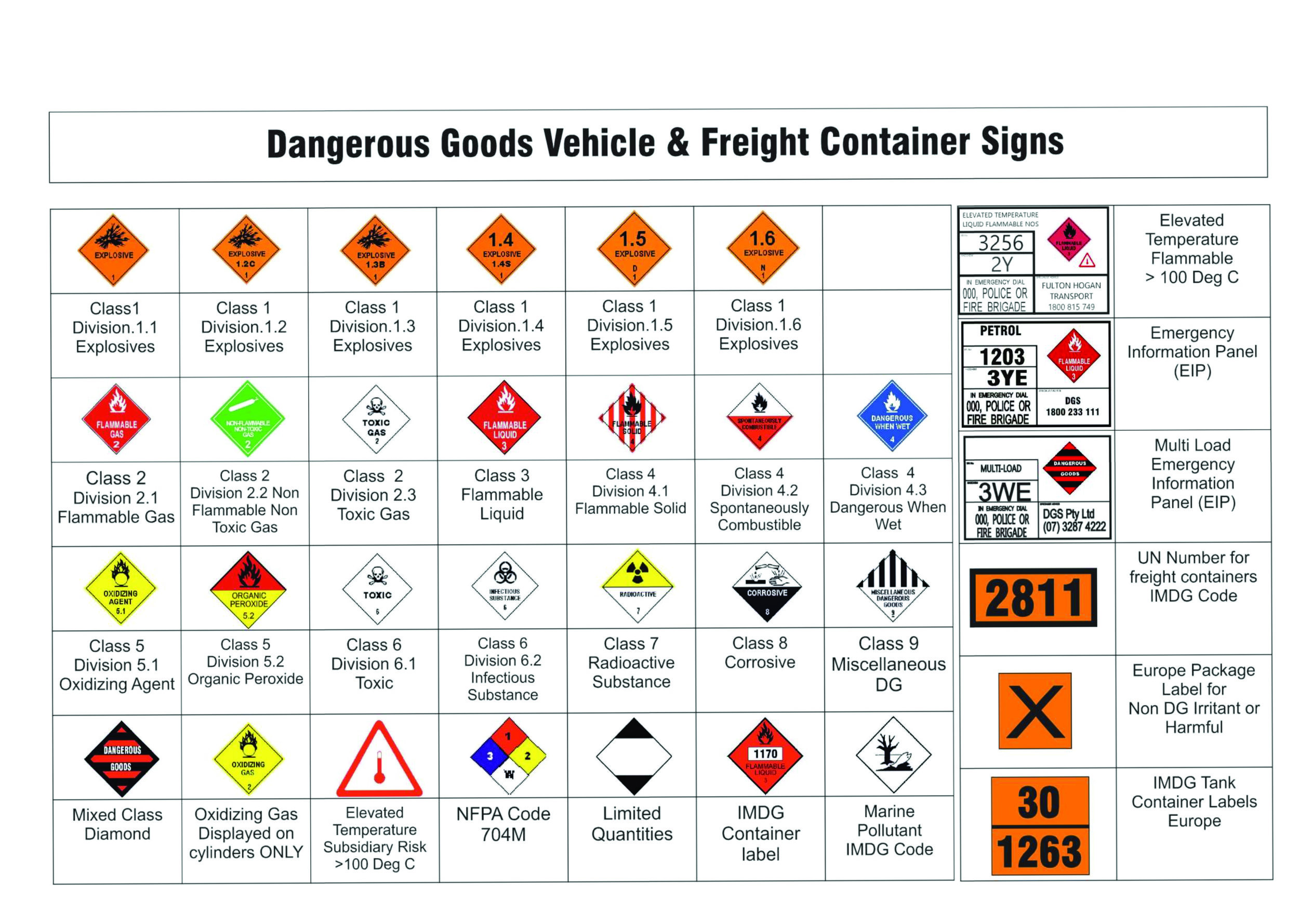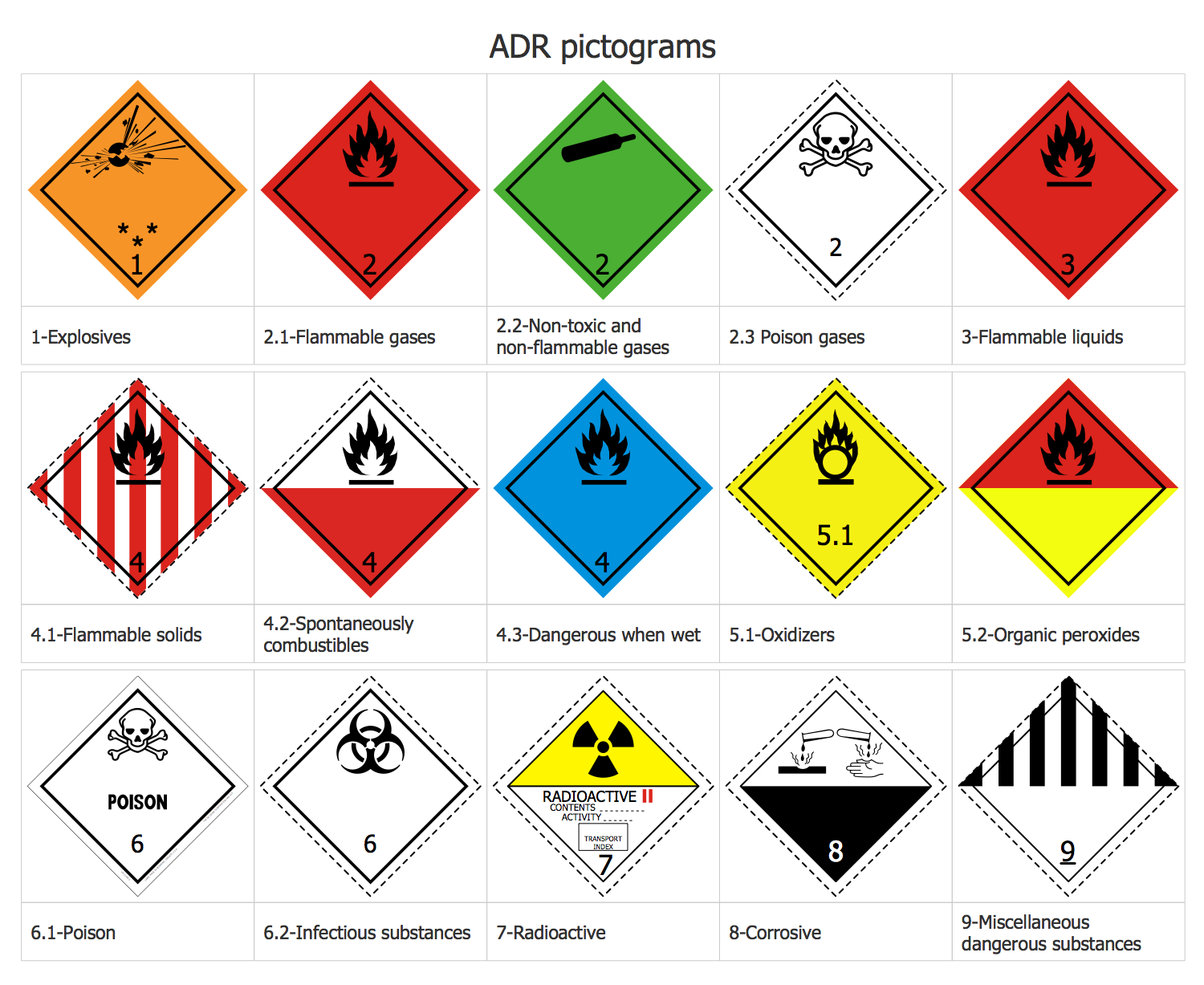39 dangerous goods transport labels
Australian Dangerous Goods Code | National Transport Commission For information on transporting dangerous goods by sea please contact the Australian Maritime Safety Authority on +61 (2) 6279 5000. For enquiries relating to the national dangerous goods transport legislative maintenance process and the national model laws, please email enquiries@ntc.gov.au. Dangerous Goods Labels - JALCARGO Transport Index (T.I.) : More than 1.0 but not more than 10: TS-DG170 (PDF Approx 204KB) 8 Corrosive: RCM: Wet Batteries, Sulfuric acid, Hydrochloric acid, Acetic acid, Sodium hydroxide solution, Gallium, Mercury, etc. Keep people and cargo away under instructions of the supervisor. TS-DG180 (PDF Approx 165KB) 9 Miscellaneous Dangerous Goods: RMD RSB ICE
Shipping Dangerous Goods - Ground Transport Guide - Labelmaster Labelmaster's DGIS Express hazmat shipping software programs streamline the process of filling out Shipper's Declaration of Dangerous Goods, UPS, FedEx, IMO and Multimodal dangerous goods form and more. You'll also find a complete selection of driver forms and vehicle inspection forms required by 49 CFR. 49 CFR
Dangerous goods transport labels
PDF Packing and Labelling Dangerous Goods for Transport Packing and Labelling Dangerous Goods for Transport 1.0 Scope This document is meant to provide guidance to allow for the safe handling, packaging, and labelling of Dangerous Goods, as defined by the Transportation of Dangerous Goods Regulations (TDGR), at Thompson Rivers University (TRU). The regulations apply when dangerous goods are received Recommendations on the Transport of Dangerous Goods - UNECE Transport Dangerous Goods Published: February 2022 These recommendations have been developed in the light of technical progress, the advent of new substances and materials, the exigencies of modern transport systems and, above all, the requirement to ensure the safety of people, property and the environment. Dangerous Goods Labels | Labels Online ADR regulations require all packages containing dangerous goods to have a warning label and that the label shall be in the form of a square at an angle of 45° (diamond shaped). All our Dangerous Goods Labels fully comply with IATA/ ICAO, UN ADR/RID and IMDG/IMO requirements and the base material conforms with BS 5609:1986.
Dangerous goods transport labels. Shipping dangerous goods: Overview - GOV.UK If you want to transport dangerous goods, there are rules on how to pack and label them and the training your staff must have. You may also need to have a dangerous goods safety adviser ( DGSA).... GHS pictograms | UNECE the GHS pictograms applicable to sectors other than transport of dangerous goods (i.e. pictograms with the red border) the pictograms for transport of dangerous goods (usually referred to as "labels" in transport of dangerous goods regulations) applicable to transport classes for which an equivalent GHS hazard class exists. Dangerous Goods Labeling & Marking Guide | Klinge Corp Transport labels for dangerous goods must be clearly printed on or affixed to the surface of the package in a location other than the bottom and near the shipping marking, as they inform how to transport, handle and store dangerous goods. On the other hand, marking conveys the specific hazards dangerous goods pose more specifically than labeling. Classes 1-9 of dangerous goods explained Dangerous goods are classified into 9 different classes, based on the dangerous properies of the goods or substance. ... Transport index Label <0.005 mSv/h: 0 >0.005 <0.5 mSv/h: 0-1 >0.5 <2 mSv/h: 1-10: Other regulations and labels apply to radioactive waste and materials exceeding the limits for Type A packages. See also: List of all items in ...
Marking & Labeling Your Shipment - Federal Aviation Administration Marking & Labeling Your Shipment. Marking and labeling are important steps when preparing a dangerous good package for transportation. Labels often communicate the hazards associated with the package, and markings ensure the shipment is handled so that spills, accidents and exposure are prevented. As such, they must be applied appropriately, ... Understanding Shipping Labels and Placards for Radioactive Materials ... UN numbers range from UN0001 to about UN3518 and are assigned by the United Nations Committee of Experts on the Transport of Dangerous Goods. NA numbers ( N orth A merica), also known as DOT numbers are issued by the United States Department of Transportation and are identical to UN numbers , except that some substances without a UN number may ... Marking and Labelling of Dangerous Goods - ChemSafetyPro.COM Dangerous goods packages must be marked and labelled before they are assigned for shipment. The differences between marking and labelling under TDG are listed as below: Marking : mainly refers to UN number, proper shipping names, UN specification marks and other markings if applicable(i.e. orientation arrows, environmental hazardous substances mark for UN 3077 and UN 3082 and excepted quantities mark); Dangerous Goods Labels | ANA Cargo Dangerous Goods Labels Dangerous goods are the substances that apply to more than one class/division defined in the "United Nations Recommendations on the Transport of Dangerous Goods." The recommendation defines dangerous goods into nine distinct classes and several divisions within.
Dangerous Goods Labels/Packaging Labels Archives - Labeline.com The signed documentation that accompanies your dangerous goods label is likely to be completed by an employee who is then legally responsible for that shipment. You need to ensure your dangerous goods packaging, inner packaging, DG labelling and documents comply with international regulations and standards. Leading Regulatory Provider Transporting dangerous or hazardous goods | Waka Kotahi NZ Transport Agency Commonly available goods that are classified as dangerous for transport include: ammunition and fireworks aerosol canisters LPG cylinders oxyacetylene cylinders compressed air cylinders for scuba diving flammable liquids such as petrol, kerosene, methylated spirits, turpentine, thinners, solvent based paints and epoxy resin hardener for epoxy resin Dangerous goods - Wikipedia The most widely applied regulatory scheme is that for the transportation of dangerous goods. The United Nations Economic and Social Council issues the UN Recommendations on the Transport of Dangerous Goods, which form the basis for most regional, national, and international regulatory schemes.For instance, the International Civil Aviation Organization has developed dangerous goods regulations ... Dangerous Goods Placards and Panels - Transport and Storage Signs Our Dangerous Goods Panels & Placards covers most all popular Labels, Panels and Placards. Indeed, a great collection of Emergency Information Panels for Transport and Storage and DG Placards and associated signs. Also, we offer many different materials and sizes to suit your needs. Furthermore, National Safety Signs sell flip cards and ...
Labeling Regulations for Chemical Transportation - OnlineLabels The Transportation of Dangerous Goods is widely accepted around the world as the standard for labeling chemicals for transport. It covers nine classes of dangerous goods by way of road, air, and sea. It's the manufacturer's responsibility to correctly classify, pack, and document the dangerous goods. If the label is at all disturbed during ...
IATA - Labels & Markings - International Air Transport Association Labels & Marks. IATA offers a wide variety of fully compliant labels and marks that may be required on packages of dangerous goods. Time & Temperature Sensitive Labels including blank labels with pre-printed temperature ranges. Volume discounts are available when ordering in quantities of 25+/50+. T hese discounts will automatically be applied ...
What You Need To Know About The Transport Of Dangerous Goods By Air How Do You Mark and Label Dangerous Goods Every package containing dangerous good must be appropriately labeled for shipment. This includes labels for their classification, handling, and any other required information. The labels should be affixed in plain sight with no other labeling present that does not apply.

Labels used in the transportation of dangerous goods by air (2017-2018 edition) | Dangerous ...
PDF Transporting Dangerous Goods Safely - Ministry of Transport For land transport, the term 'Dangerous Goods' replaced the previously used term of 'Hazardous Substances', with the introduction of the Land Transport Rule: Dangerous Goods 1999. This rule has now been updated and replaced by the Land Transport Rule: Dangerous Goods 2005 with effect from 27 June 2005.
Dangerous Goods Safety Marks - Transport Canada Part 4 of the TDG Regulations requires dangerous goods safety marks to be displayed on a means of containment containing dangerous goods in transport. A dangerous goods safety mark can be a label, placard, orange panel, sign, mark, letter, word, number or abbreviation, or any combination of these things. Dangerous goods safety marks are displayed on a means of containment to identify dangerous goods and to show the nature of the danger they pose.
PDF Guidance Note 042 Australian Dangerous Goods Code You can find this document on the National Transport Commission website Class 1.5 - Explosives with a mass explosion hazard, but are insensitive substances. (Orange background) Class 1.6 - Substances which are a minor explosion hazard, very insensitive substances. (Orange background) Class 2.1
DANGEROUS GOODS: CLASSES AND LABELING - Transped Each classification is identified with labels that express the risks of the goods when they are transported. The international ADR regulations include the following types. Class 1 Label with a black bomb explosion icon on an orange background and the number 1 at the bottom.
Dangerous goods labels | Noatum Logistics - Global - Dangerous goods labels must be used in transport to identify the risks of the products being transported. Goods are classified according to the international regulation ADR 2019 (European Agreement on the Transport of Dangerous Goods by Road) based on their composition and degree of danger. Class 1: Explosive substances and articles.
Dangerous goods classes and hazard labels - Civil Aviation Safety Authority Hazard labels for dangerous goods These labels must be clearly visible on the outside of the package and must stay on the package while it's in transit. The labels are often printed on most inner packages such as aerosol cans, bottles of bleach, containers of thinners, tins of paint, and many other products which are available at supermarkets and hardware stores.

Labels used in the transportation of dangerous goods by air (2017-2018 edition) | Dangerous ...
Transporting dangerous goods - GOV.UK The Vehicle Certification Agency ( VCA) Dangerous Goods Office is responsible for the certification of dangerous goods packaging within the UK. ADR / RID packaging and technical enquiries Contact...
Hazard labels for the transportation of dangerous goods for download With the label class 2 "toxic gases" or class 6.1 "toxic substances" there is no need for the ...
Comparison of GHS Labels and Dangerous Goods Labels - ChemSafetyPro.COM Dangerous goods labels are usually required by dangerous goods transport regulations such as IMDG Code, IATA, and ADR. Those regulations are based on the UN Recommendations on the Transport of Dangerous Goods Model Regulations. The primary purpose of DG labels is to ensure the safe transport of dangerous goods by via various modes (air, sea or ...
Dangerous Goods Labels | Labels Online ADR regulations require all packages containing dangerous goods to have a warning label and that the label shall be in the form of a square at an angle of 45° (diamond shaped). All our Dangerous Goods Labels fully comply with IATA/ ICAO, UN ADR/RID and IMDG/IMO requirements and the base material conforms with BS 5609:1986.
Recommendations on the Transport of Dangerous Goods - UNECE Transport Dangerous Goods Published: February 2022 These recommendations have been developed in the light of technical progress, the advent of new substances and materials, the exigencies of modern transport systems and, above all, the requirement to ensure the safety of people, property and the environment.
PDF Packing and Labelling Dangerous Goods for Transport Packing and Labelling Dangerous Goods for Transport 1.0 Scope This document is meant to provide guidance to allow for the safe handling, packaging, and labelling of Dangerous Goods, as defined by the Transportation of Dangerous Goods Regulations (TDGR), at Thompson Rivers University (TRU). The regulations apply when dangerous goods are received








Post a Comment for "39 dangerous goods transport labels"